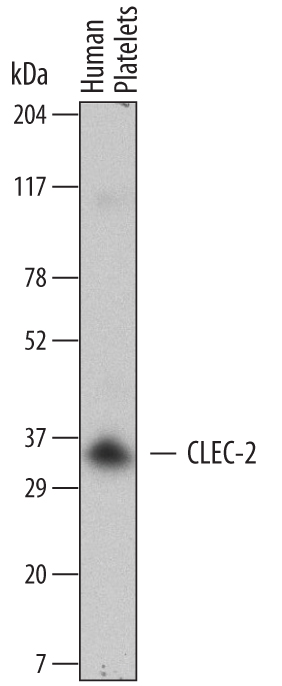Human CLEC-2/CLEC1B Antibody Summary
CLEC-1 is observed.
Gln58-Pro229
Accession # AAF36777
Applications
Please Note: Optimal dilutions should be determined by each laboratory for each application. General Protocols are available in the Technical Information section on our website.
Scientific Data
 View Larger
View Larger
Detection of Human CLEC-2/CLEC1B by Western Blot. Western blot shows lysates of human platelets. PVDF Membrane was probed with 2 µg/mL of Mouse Anti-Human CLEC-2/CLEC1B Monoclonal Antibody (Catalog # MAB1718) followed by HRP-conjugated Anti-Mouse IgG Secondary Antibody (Catalog # HAF007). A specific band was detected for CLEC-2/CLEC1B at approximately 35 kDa (as indicated). This experiment was conducted under reducing conditions and using Immunoblot Buffer Group 5.
Reconstitution Calculator
Preparation and Storage
- 12 months from date of receipt, -20 to -70 °C as supplied.
- 1 month, 2 to 8 °C under sterile conditions after reconstitution.
- 6 months, -20 to -70 °C under sterile conditions after reconstitution.
Background: CLEC-2/CLEC1B
C-type lectin-like receptor 2 (CLEC-2) is a 32 kDa type II transmembrane glycoprotein and member of the C-type lectin-like family of receptors (1-4). CLEC-2 consists of a 33 amino acid (aa) cytoplasmic domain, a 21 aa transmembrane region, and a 175 aa extracellular domain. The cytoplasmic domain contains multiple threonine and serine residues which are sites of potential phosphorylation, and a YXXL (Tyr-Xaa-Xaa-Leu) motif through which CLEC-2 does its signaling (2, 4-5). Ligand binding and cross-linking of CLEC-2 induces Src kinase-dependent tyrosine phosphorylation of the YXXL sequence, inducing activation of the tyrosine kinase Syk and initiation of a signaling pathway that culminates in activation of phospholipase C gamma 2 (2, 5). The extracellular domain contains three potential sites of N-linked glycosylation, and a single carbohydrate recognition domain (CRD) which shows conservation of six cysteine residues (1, 6). Unlike most other members of the
C‑type lectin-like family of receptors, CLEC-2's CRD lacks the amino acid residues that are crucial for Ca2+-dependent carbohydrate binding, making it a
non‑classical C-type lectin receptor (1, 6). A splicing variant at aa 22-55 produces two isoforms for CLEC-2. Isoform 1 is the longer protein, and in isoform 2, an alanine residue is substituted for aa 22-55. Human CLEC-2 shares 63% aa sequence identity with mouse CLEC-2. CLEC-2 is expressed preferentially in liver, and is also detected in myeloid cells (monocytes, dendritic cells, and granulocytes) (1), platelets, and megakaryocytes (4). CLEC-2 is the receptor for the
platelet-aggregating snake venom protein rhodocytin (3-4) and the molecule podoplanin, a transmembrane sialoglycoprotein that, when bound to CLEC-2, is involved in platelet aggregation, tumor metastasis, and lymphatic vessel formation (2, 7). CLEC-2 has also been shown to enhance infectivity of HIV-1 by mediating HIV-1 attachment and transfer by CLEC-2 transfected cells and platelets (8).
-
Colonna, M. et al. (2000) Eur. J. Immunol. 30:697.
- Christou, C.M. et al. (2008) Biochem. J. 411:133.
- Watson, A.A. et al. (2007) J. Biol. Chem. 282:3165.
- Suzuki-Inoue, K. et al. (2006) Blood 107:542.
- Fuller, G.L. et al. (2007) J. Biol. Chem. 282:12397.
- Weis, W.I. et al. (1998) Immunol. Rev. 163:19.
- Suzuki-Inoue, K. et al. (2007) J. Biol. Chem. 282:25993.
- Chaipan, C. et al. (2006) J. Virol. 80:8951.
Product Datasheets
Citations for Human CLEC-2/CLEC1B Antibody
R&D Systems personnel manually curate a database that contains references using R&D Systems products. The data collected includes not only links to publications in PubMed, but also provides information about sample types, species, and experimental conditions.
3
Citations: Showing 1 - 3
Filter your results:
Filter by:
-
Microenvironment inflammatory infiltrate drives growth speed and outcome of hepatocellular carcinoma: a prospective clinical study
Authors: R Critelli, F Milosa, F Faillaci, R Condello, E Turola, L Marzi, B Lei, F Dituri, S Andreani, P Sighinolfi, P Manni, A Maiorana, C Caporali, F di Benedet, M Del Buono, N De Maria, F Schepis, ML Martinez-C, G Giannelli, E Villa
Cell Death Dis, 2017-08-24;8(8):e3017.
Species: Human
Sample Types: Tissue Homogenates
Applications: Western Blot -
Inhibitory effects of polypeptides derived from a snake venom C-type lectin, aggretin, on tumor cell-induced platelet aggregation.
Authors: Chang C, Chung C, Hsu C, Peng H, Huang T
J Thromb Haemost, 2014-04-01;12(4):540-9.
Species: Human
Sample Types: Plasma
Applications: Western Blot -
A novel mechanism of cytokine release in phagocytes induced by aggretin, a snake venom C-type lectin protein, through CLEC-2 ligation.
Authors: Chang CH, Chung CH, Hsu CC, Huang TY, Huang TF
J. Thromb. Haemost., 2010-11-01;8(11):2563-70.
Species: Human
Sample Types: Cell Lysates, Whole Cells
Applications: Flow Cytometry, Western Blot
FAQs
No product specific FAQs exist for this product, however you may
View all Antibody FAQsReviews for Human CLEC-2/CLEC1B Antibody
There are currently no reviews for this product. Be the first to review Human CLEC-2/CLEC1B Antibody and earn rewards!
Have you used Human CLEC-2/CLEC1B Antibody?
Submit a review and receive an Amazon gift card.
$25/€18/£15/$25CAN/¥75 Yuan/¥2500 Yen for a review with an image
$10/€7/£6/$10 CAD/¥70 Yuan/¥1110 Yen for a review without an image

